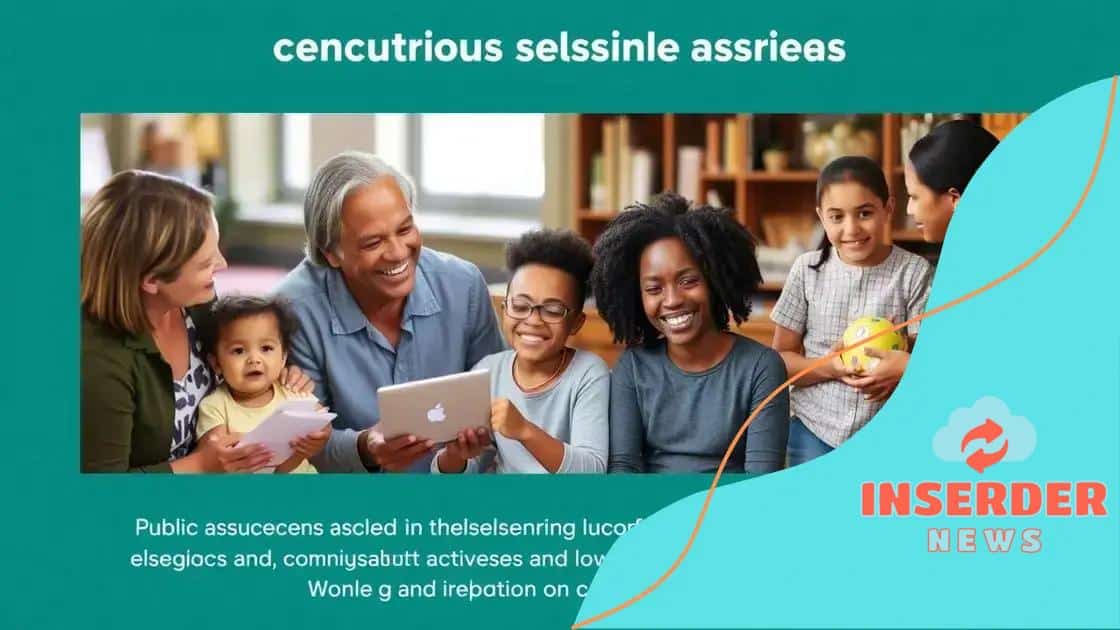The role of public benefits in addressing homelessness

The role of public benefits in addressing homelessness is crucial, as these programs provide essential resources that help individuals regain stability and prevent further financial hardships.
The role of public benefits in addressing homelessness is a significant topic that impacts communities. Have you ever wondered how these benefits truly change lives? Let’s dive in!
Understanding public benefits and their purpose
Understanding public benefits and their purpose is crucial for addressing issues like homelessness. These programs provide essential support to individuals and families in need. By offering financial assistance and resources, public benefits play a vital role in helping people regain stability.
What Are Public Benefits?
Public benefits encompass a wide range of programs designed to aid those facing economic hardship. These include:
- Temporary Assistance for Needy Families (TANF)
- Supplemental Nutrition Assistance Program (SNAP)
- Medicaid and Medicare
- Housing assistance programs
Each of these programs serves a specific purpose, ensuring that individuals have access to food, healthcare, and housing. Without these benefits, many would struggle to meet basic needs.
The Importance of Access
Access to public benefits can make a significant difference in the lives of those experiencing financial difficulties. It can help families avoid eviction, secure nutritious food, and cover medical expenses. The impact of these benefits goes beyond individual families; they contribute to community health and stability.
For instance, when people receive necessary support, they are less likely to fall into deeper poverty. This stabilizes neighborhoods and reduces overall societal costs.
Why Awareness Matters
Raising awareness about public benefits is essential for helping those who need it most. Many individuals may not know what programs are available or how to apply. Outreach efforts that inform people about their rights can lead to increased participation in these vital programs.
Additionally, communities can advocate for better resources and policies that enhance the effectiveness of public benefits. When residents are engaged and informed, they can push for the changes needed to support each other better.
Understanding the scope and purpose of public benefits empowers community members and fosters a supportive environment. By working together, we can ensure that everyone has access to the resources they need to thrive.
Key programs aimed at reducing homelessness
Key programs aimed at reducing homelessness provide essential support for individuals and families struggling to find stable housing. Understanding these programs can help communities better assist those in need.
Housing First Initiative
The Housing First initiative is a highly successful approach. It focuses on providing immediate access to housing without preconditions. This method allows individuals to stabilize their lives while offering supportive services as needed. Studies show that this approach significantly reduces homelessness.
Transitional Housing Programs
Transitional housing offers temporary accommodations combined with support services. These programs typically last from six months to two years, assisting individuals in transitioning to permanent housing. Participants receive guidance on budgeting, job training, and securing stable employment, making it easier to maintain their housing.
- Supportive counseling services
- Job readiness programs
- Financial literacy training
Such programs empower individuals with the tools they need. They help break the cycle of homelessness and prepare people for independent living.
Emergency Shelter Services
Emergency shelters are crucial for those facing immediate housing crises. They provide a safe place to stay and essential services. Many shelters also connect individuals with resources for long-term support. This helps people find permanent housing.
Additionally, shelters often include case management and referrals to other services, such as mental health support and substance abuse treatment. These comprehensive services are essential for those re-entering stable housing.
Subsidized Housing Programs
Subsidized housing programs play a vital role in keeping housing affordable for low-income families. By providing financial assistance with rent, these programs ensure that individuals do not become homeless due to financial difficulties. They allow families to allocate money toward other essential needs like food and healthcare.
Key subsidized housing initiatives include:
- Section 8 Housing Choice Voucher Program
- Public Housing Authorities
- Low-Income Housing Tax Credit (LIHTC)
Each of these programs provides critical support, making homeownership achievable and preventing homelessness.
Success stories: Public benefits in action

Success stories about public benefits in action showcase the positive impact these programs have on individuals and families. Many people have transformed their lives through the support they received, highlighting the importance of these resources.
Case Study: Maria’s Journey
Maria was a single mother living in her car with her two children. Thanks to the Emergency Shelter Program, she found temporary housing where she received food and counseling. With guidance, Maria applied for the Housing Choice Voucher Program and secured a stable apartment for her family.
Additionally, Maria took advantage of job training programs funded by public benefits, helping her gain employment. Today, she works full-time and is actively involved in her community, demonstrating how effective support can spark change.
Transformative Experience: James and the Housing First Approach
James was previously homeless for several years. With the help of the Housing First initiative, he was offered immediate housing without stringent requirements. This program allowed him to focus on rebuilding his life.
While living in his new apartment, James received access to mental health services and job placement assistance. As a result, he not only found stability but also regained hope for the future.
A Community Impact: Local Success Program
A local nonprofit implemented a supportive housing program that helped hundreds. Participants received case management and resources to secure employment and permanent housing. Many families reported increased well-being and improved relationships.
- Over 70% of participants transitioned to permanent housing.
- Many found stable jobs through job training and placement services.
- Participants expressed higher satisfaction with their living conditions.
These success stories illustrate the vital role that public benefits play in transforming lives. Access to essential services fosters resilience and empowers individuals to become self-sufficient.
Seeing these positive outcomes reinforces the need for continued funding and support for public benefit programs. By sharing these stories, we can inspire others to advocate for systems that uplift those in need.
Challenges faced in implementing benefits
Challenges faced in implementing benefits can hinder the effectiveness of programs aimed at reducing homelessness. Various barriers can prevent individuals from accessing the help they need.
Complex Application Processes
One major challenge is the complexity of application processes for public benefits. Many programs require extensive documentation, which can be overwhelming for those already in crisis. Individuals may struggle to gather necessary paperwork, such as proof of income or residency. This can lead to frustration and discourage people from applying.
Lack of Awareness
Many people are unaware of the benefits available to them. Outreach efforts often fall short, failing to connect with those who would benefit most. For instance, marginalized communities may face barriers, including language differences and lack of access to technology.
- Limited access to information about available programs.
- Language barriers that leave some individuals confused.
- Insufficient outreach in underserved neighborhoods.
These factors contribute to underutilization of valuable resources aimed at helping those in need.
Funding Shortages
Another significant challenge is funding shortages. Many public benefit programs rely on government resources, which can fluctuate annually. When budgets are cut, programs may struggle to maintain services or reach more people.
This often results in longer wait times for applicants and reduced services, ultimately affecting those seeking assistance. Adequate funding is essential to ensure that programs remain effective and available.
Administrative Barriers
Administrative barriers can further complicate access to benefits. Different agencies may have varying requirements and procedures, creating confusion for applicants. Inconsistent policies may lead to frustrations that discourage individuals from following through with applications.
In some cases, these administrative complexities can result in errors that delay the approval process. Simplifying administrative tasks is crucial for easing access to benefits.
Addressing these challenges is vital in improving the implementation of public benefits. Recognizing and overcoming the barriers can lead to more effective systems of support, allowing individuals to get the help they need.
Future strategies for effective public assistance
Future strategies for effective public assistance are essential for addressing the evolving needs of communities. As society changes, so must the approaches to assisting those in need.
Emphasizing Technology in Benefit Access
Integrating technology into public assistance programs can improve accessibility and efficiency. Online applications and digital resources streamline the process for individuals seeking help. For instance, mobile apps can provide users with information on available benefits, application procedures, and deadlines.
- Mobile-friendly applications allow users to apply anytime.
- Online resources offer guidance in multiple languages.
- Virtual consultations can replace in-person meetings, increasing accessibility.
Using technology not only saves time but also enhances the user experience, making it easier for people to navigate the system.
Community-Based Programs
Future strategies should focus on community-based programs that empower local organizations. By investing in these organizations, governments can create tailored solutions that meet the specific needs of diverse populations.
Community engagement through outreach efforts fosters trust and encourages participation in public assistance programs. This approach can lead to:
- Stronger partnerships between government and local nonprofits.
- Programs that reflect the unique circumstances of different communities.
- Enhanced support networks that improve service delivery.
A community-centered model ensures that assistance is relevant and effective.
Long-Term Support Systems
Another key strategy is to focus on long-term support systems rather than just emergency assistance. Providing ongoing support and resources can help individuals stabilize and thrive, rather than just survive.
Programs that offer job training, financial literacy, and mental health services can create a more sustainable path toward economic independence. Key components include:
- Continued education and skill development opportunities.
- Access to affordable childcare for working parents.
- Support services that promote holistic well-being.
By addressing the root causes of poverty and homelessness, these programs can help break the cycle.
Implementing future strategies for effective public assistance can lead to lasting change. These innovative approaches, focused on technology, community engagement, and long-term support, offer a roadmap for improving outcomes for those in need.
FAQ – Frequently Asked Questions about Public Benefits and Homelessness
What are public benefits?
Public benefits are government programs designed to support individuals and families in need, providing assistance such as food, housing, and healthcare.
How do public benefits help reduce homelessness?
Public benefits provide essential resources that help individuals regain stability, such as housing assistance, job training, and mental health support, thus reducing the risk of homelessness.
What challenges do people face when accessing public benefits?
Common challenges include complex application processes, lack of awareness about available programs, and insufficient funding for services.
What future strategies can improve public assistance programs?
Future strategies may include leveraging technology for easier access, focusing on community engagement, and ensuring ongoing support for individuals to promote long-term stability.






